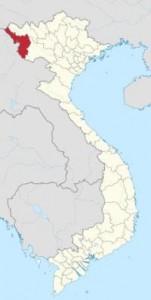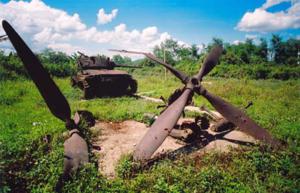A province in north-western Vietnam, Dien Bien adjoins Lai Chau Province and Son La Province of Vietnam, Van Nam Province of China and Phongsali province of Laos. It is constituted by 7 districts named Dien Bien, Dien Bien Dong, Muong Ang, Muong Cha, Muong Nhe, Tua Chua, Tuan Giao. The capital of the province is Dien Bien Phu, a city most known for its long and victorious history against French colonists on 7/5/1954. Besides celebrated historic relics, like other mountainous provinces, Dien Bien offers fascinating natural scenery which one should not miss.
 Location and history
Location and history
Dien Bien is among the six mountainous provinces in Northwestern Vietnam. The district is next to Lai Chau and Son La provinces and has long borders with China to the North and Laos to West. Dien Bien City is located inside the heart-shaped Muong Thanh Valley, surrounded by numerous thick forests, high mountains, narrow valleys and springs. The climate of Dien Bien is mountainous tropical whose temperature may fall below 0oC in cold season, while the highest temperature fluctuates around 28oC in hot season.
Dien Bien map
This province is proven to be one of the most ancient lands of Vietnam as many signs of ancient Vietnamese during 9-10th centuries have been discovered here. The name Dien Bien was given by King Thieu Tri – The 3rd king of Nguyen Dynasty in the year 1841. “Dien” means solid while “Bien” means frontiers, so the name means solid defensive frontiers.
The triumph of Dien Bien Phu Campain on 7/5/1954 made this rural area phenomenal all over the five continents of the world which ended 80 years dominated by colonial-half-feudal system of Vietnam. On 26/9/2003, Vietnamese Government signed the official document giving birth to Dien Bien City.
Dien Bien vestiges of war
 Attaching with the historic victory of Dien Bien Phu campain is a wide range of vestiges which are well preserved until present. Each of the vestiges reminds Vietnamese people as well as the international public of a fierce but proud battlefield during resistance war against French invaders. Among those heroic vestiges, the underground hideout of French General De Castries should be the most eloquent evidence of the bravery of Vietnamese troops, who fought incessantly for 54 days and nights to seize it. This historical monument has been being well preserved that still maintains its original shape, dimension and structure.
Attaching with the historic victory of Dien Bien Phu campain is a wide range of vestiges which are well preserved until present. Each of the vestiges reminds Vietnamese people as well as the international public of a fierce but proud battlefield during resistance war against French invaders. Among those heroic vestiges, the underground hideout of French General De Castries should be the most eloquent evidence of the bravery of Vietnamese troops, who fought incessantly for 54 days and nights to seize it. This historical monument has been being well preserved that still maintains its original shape, dimension and structure.
Dien Bien Phu War Remnants
Hill A1, located in Muong Thanh Ward, plays a critic part in controlling the whole battle of Dien Bien Phu campaign. Standing on the top of Hill A1 while listening to a tour-guide briefing about the 1954 campaign, ones may have a sense of attending the battlefield. In addition, having a visit at cemeteries of Vietnamese soldiers scarified in the campaign should be good deep of visitors when coming to Hill A1.
Another indispensible vestige to mention is the command post of Vietnamese soldiers hidden inside the forest of Muong Phang commune. Here, the renowned General Vo Nguyen Giap and Vietnamese military used to work and plan for the glorious Dien Bien Phu Victory.
Besides, Muong Thanh Airfield, Doc Lap Hill, Him Lam Hill, Dien Bien Phu Victorious Statue and Dien Bien Phu Victory Museum are recommended to visit.
